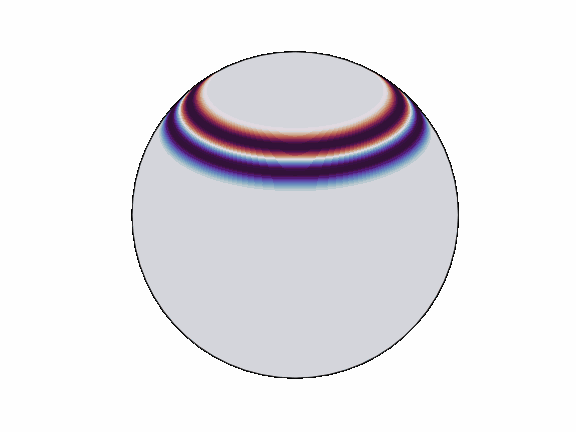Overview | Installation | More information | Getting started | Contributors | Cite us | References
torch-harmonics implements differentiable signal processing on the sphere. This includes differentiable implementations of the spherical harmonic transforms, vector spherical harmonic transforms and discrete-continuous convolutions on the sphere. The package was originally implemented to enable Spherical Fourier Neural Operators (SFNO) [1].
The SHT algorithm uses quadrature rules to compute the projection onto the associated Legendre polynomials and FFTs for the projection onto the harmonic basis. This algorithm tends to outperform others with better asymptotic scaling for most practical purposes [2].
torch-harmonics uses PyTorch primitives to implement these operations, making it fully differentiable. Moreover, the quadrature can be distributed onto multiple ranks making it spatially distributed.
torch-harmonics has been used to implement a variety of differentiable PDE solvers which generated the animations below. Moreover, it has enabled the development of Spherical Fourier Neural Operators (SFNOs) [1].
A simple installation can be directly done from PyPI:
pip install torch-harmonicsIf you are planning to use spherical convolutions, we recommend building the corresponding custom CUDA kernels. To enforce this, you can set the FORCE_CUDA_EXTENSION flag. You may also want to set appropriate architectures with the TORCH_CUDA_ARCH_LIST flag. Finally, make sure to disable build isolation via the --no-build-isolation flag to ensure that the custom kernels are built with the existing torch installation.
export FORCE_CUDA_EXTENSION=1
export TORCH_CUDA_ARCH_LIST="7.0 7.2 7.5 8.0 8.6 8.7 9.0+PTX"
pip install --no-build-isolation torch-harmonicsIf you want to actively develop torch-harmonics, we recommend building it in your environment from github:
git clone git@github.com:NVIDIA/torch-harmonics.git
cd torch-harmonics
pip install -e .Alternatively, use the Dockerfile to build your custom container after cloning:
git clone git@github.com:NVIDIA/torch-harmonics.git
cd torch-harmonics
docker build . -t torch_harmonics
docker run --gpus all -it --rm --ipc=host --ulimit memlock=-1 --ulimit stack=67108864 torch_harmonicsThe spherical harmonics are special functions defined on the two-dimensional sphere
where
The spherical harmonic transform (SHT)
realizes the projection of a signal
where
The implementation of the SHT follows the algorithm as presented in [2]. A direct spherical harmonic transform can be accomplished by a Fourier transform
in longitude and a Legendre transform
in latitude.
The second integral, which computed the projection onto the Legendre polynomials is realized with quadrature. On the Gaussian grid, we use Gaussian quadrature in the
is obtained with the substitution
Here,
torch-harmonics now provides local discrete-continuous (DISCO) convolutions as outlined in [4] on the sphere.
The main functionality of torch_harmonics is provided in the form of torch.nn.Modules for composability. A minimum example is given by:
import torch
import torch_harmonics as th
device = torch.device('cuda' if torch.cuda.is_available() else 'cpu')
nlat = 512
nlon = 2*nlat
batch_size = 32
signal = torch.randn(batch_size, nlat, nlon, device=device)
# transform data on an equiangular grid
sht = th.RealSHT(nlat, nlon, grid="equiangular").to(device)
coeffs = sht(signal)To enable scalable model-parallelism, torch-harmonics implements a distributed variant of the SHT located in torch_harmonics.distributed.
Detailed usage of torch-harmonics, alongside helpful analysis provided in a series of notebooks:
- Getting started
- Quadrature
- Visualizing the spherical harmonics
- Spectral fitting vs. SHT
- Conditioning of the Gramian
- Solving the Helmholtz equation
- Solving the shallow water equations
- Training Spherical Fourier Neural Operators (SFNO)
- Resampling signals on the sphere
Note that torch-harmonics uses Fourier transforms from torch.fft which in turn uses kernels from the optimized cuFFT library. This library supports fourier transforms of float32 and float64 (i.e. single and double precision) tensors for all input sizes. For float16 (i.e. half precision) and bfloat16 inputs however, the dimensions which are transformed are restricted to powers of two. Since data is converted to one of these reduced precision floating point formats when torch.autocast is used, torch-harmonics will issue an error when the input shapes are not powers of two. For these cases, we recommend disabling autocast for the harmonics transform specifically:
import torch
import torch_harmonics as th
sht = th.RealSHT(512, 1024, grid="equiangular").cuda()
with torch.autocast(device_type="cuda", enabled = True):
# do some AMP converted math here
x = some_math(x)
# convert tensor to float32
x = x.to(torch.float32)
# now disable autocast specifically for the transform,
# making sure that the tensors are not converted
# back to reduced precision internally
with torch.autocast(device_type="cuda", enabled = False):
xt = sht(x)
# continue operating on the transformed tensor
xt = some_more_math(xt)Depending on the problem, it might be beneficial to upcast data to float64 instead of float32 precision for numerical stability.
Boris Bonev (bbonev@nvidia.com), Thorsten Kurth (tkurth@nvidia.com), Mauro Bisson , Massimiliano Fatica, Nikola Kovachki, Jean Kossaifi, Christian Hundt
If you use torch-harmonics in an academic paper, please cite [1]
@misc{bonev2023spherical,
title={Spherical Fourier Neural Operators: Learning Stable Dynamics on the Sphere},
author={Boris Bonev and Thorsten Kurth and Christian Hundt and Jaideep Pathak and Maximilian Baust and Karthik Kashinath and Anima Anandkumar},
year={2023},
eprint={2306.03838},
archivePrefix={arXiv},
primaryClass={cs.LG}
}[1] Bonev B., Kurth T., Hundt C., Pathak, J., Baust M., Kashinath K., Anandkumar A.; Spherical Fourier Neural Operators: Learning Stable Dynamics on the Sphere; International Conference on Machine Learning, 2023. arxiv link
[2] Schaeffer N.; Efficient spherical harmonic transforms aimed at pseudospectral numerical simulations; G3: Geochemistry, Geophysics, Geosystems, 2013.
[3] Wang B., Wang L., Xie Z.; Accurate calculation of spherical and vector spherical harmonic expansions via spectral element grids; Adv Comput Math, 2018.
[4] Ocampo, Price, McEwen, Scalable and equivariant spherical CNNs by discrete-continuous (DISCO) convolutions, ICLR (2023), arXiv:2209.13603




